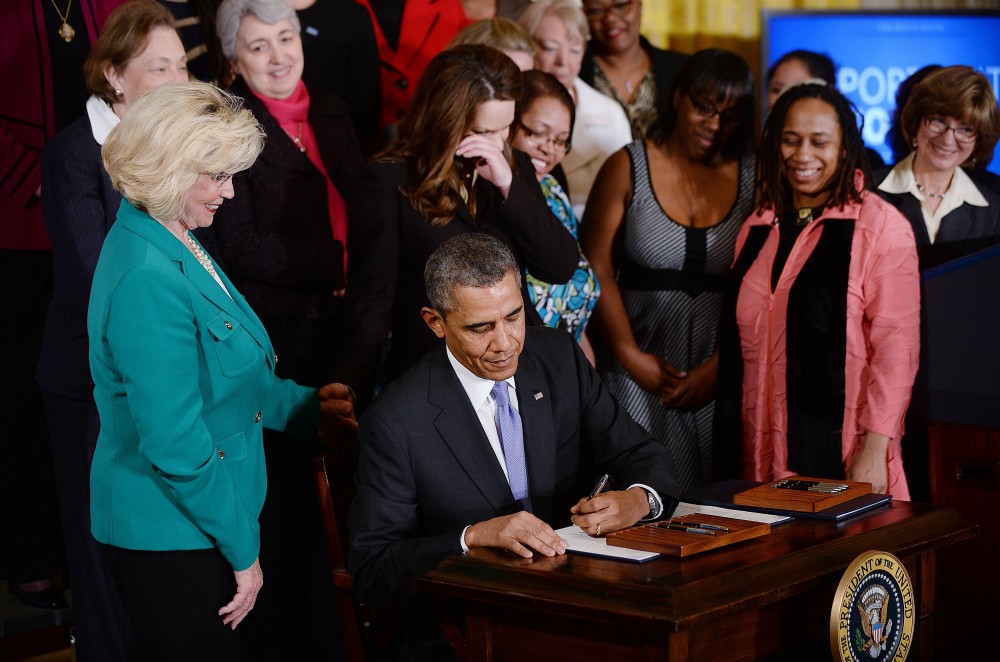EDITORIAL
St. Louis Post-Dispatch.
Equal Pay Day was observed on Tuesday in the way it is every year, more in the breach than the observance. Yes, President Barack Obama called gender wage inequity an “embarrassment,” and yes, the U.S. Senate again dithered casually with the Paycheck Fairness Act.
And so it’s gone since 1963 when the Equal Pay Act was signed and statistics on the gap began being generated and publicized.
At that time women were making 59 cents on average for every dollar earned by men.
Over the past 51 years, wars have been won and lost, the Soviet Union collapsed, nations have changed names and leadership, America twice elected a black president and gay marriage has been legalized in 17 states. The pay gap remains.
There have been gains — about 18 cents worth, by some measures. The shorthand says women now make 77 cents on the dollar for doing the same work as men.
Even though math is fact-based, this figure is political. Some sociologists and some economists say numbers from the U.S. Bureau of Labor Statistics show the 77-cent figure to be inaccurate.
They say it doesn’t take into account such things as the different definitions of “full time,” and suggest a better snapshot can be had by comparing average weekly wages instead of annual wages.
When a variety of details are factored in — such as race, education and experience — some statistics show that women earn roughly between 81 percent and 94 percent of what men make.
An analysis released for Equal Pay Day says the gap in Missouri is a cent higher, with women getting paid 76 cents on the dollar, amounting to an annual wage disparity of $10,106. Missouri has the 17th largest gender wage gap in the country, according to the study by the National Partnership for Women & Families.
Aside from fundamental fairness, one reason this is important is that women are the sole heads of 292,000 households in Missouri.
Women across the country make up nearly half the workforce and are the essential breadwinners in two-thirds of households.
So while the size of the pay gap may be debatable, the fact of it is not. In many ways, the focus on a tidy number — be it 77, 81 or 94 — distracts attention from more complex problems about wage earners, gender gaps and income inequality.
If the problem was just sexism in payrolls, it could be fixed by enlightening the nation’s bosses or (more likely) enforcing the Equal Pay Act.
The statistics show a more complicated set of problems — including whether women are choosing lower-paying professions or being forced into them, and why women work fewer hours.
Is this due to discrimination or the result of choices women make because they are still the main family caretakers in a country that doesn’t do much to support them if they stay home to raise children?
Indeed, a recent study by the Pew Economic Mobility Project shows that women’s wages are rising across all economic groups and have been doing so since 1970.
At the same time, family income is falling for the bottom 40 percent of families.
Sociologists say the best way to bridge the income inequality gap for poor and working-class people is to get married and stay that way.
A recent estimate shows that the median income for married families in 2012 was about $81,000 compared to about $25,000 for single mothers.
The nation’s high divorce rate suggests that’s often not a workable solution.
Richard Reeves, policy director of Brookings’ Center on Children and Families, wrote in The Atlantic magazine in February that: “Matrimony is flourishing among the rich but floundering among the poor, leading to a large, corresponding ‘marriage gap.'”
At the same time, wages for men in the bottom 40 percent of income-earners are declining. The result is fewer marriages and more divorces among lower-income wage earners.
The decline of stable families among the working class has fed inequality and immobility, and economic pressures are widening the gap among classes.
Mr. Reeves writes that one way to keep marriage alive is what he calls “high-investment parenting,” or “HIP” marriages. He describes these as “a child-rearing machine for a post-feminist society and a knowledge economy.” Such marriages are held together by a joint commitment to raising children in a settled, nurturing environment.
Women in these marriages “are the most economically independent women in the history of the nation,” Mr. Reeves says. “Independence, rather than dependence, underpins the new marriage.”
HIP marriages are becoming more common among educated and affluent couples. They have the money, background and temperament to cope with the rigors of child-rearing coupled with the desire and ability to share the jobs of parenting and working.
Less affluent and educated people don’t. Reeves cites a survey showing that only people with the least education continue to think men should be breadwinners.
Instead of sitting idly by while traditional marriages wither, the nation needs policies like wage subsidies, early childhood education and safe and affordable daycare to help strengthen two-parent households. The gender wage gap should be closed, of course, but the problems threatening families are bigger than that.














































































































































































































































































































































































